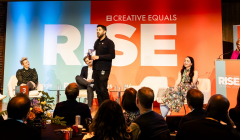
Are we leaving men and boys behind?
At Creative Equal’s RISE event, industry leaders consider how to reframe boys and men in marketing

A campaign from Mr President and SheSays highlights the importance of Equal Pay Day for the creative industries.

Women in the UK earn an average of 82 pence for every pound earned by men. A stark disparity of earnings which has been bought to life by Mr President and She Says.
The independent agency has joined forces with SheSays to mint a run of 100 ‘Pay Gap Pound’ coins, which have a value of 82 etched on them. Supporters can also generate their own ‘Pay Gap Pound’ for their profession by visiting www.paygappound.com
The coins have been distributed to 100 influential women, each of whom have pledged to support the campaign across social media with the hashtag #paygappound. These women include Sarah Pascoe and Ann Francke. The campaign will also be amplified by SheSays’ 50,000 global members.
Laura Jordan Bambach, Chief Creative Officer and Co-Founder of Mr President said, “The Pay Gap Pound coin is a physical representation of the inequality women are still facing 2019. By allowing women to generate the Pay Gap Pound for their industry, we are making it personal. Because there is nothing more personal than the cash in your pocket.”
Government policy has placed the gender pay gap firmly on the industry radar; yet the uncomfortable truth remains that many companies are regressing. According to the Office for National Statistics’ latest data, the situation for full-time employees is getting worse; the gender pay gap now stands at 8.9%, a tiny bit worse than it was in 2018, when it stood at 8.6%. These figures mean that women in Britain are paid £380,000 on average over the course of their careers, a whopping £260,000 less than men.
In advertising, agencies point to the low number of women in senior leadership positions in the industry as the reason for the disparity. Unequal pay, where women earn less than men for the same role is against the law. Employer secrecy about staff pay is also fuelling the gender pay gap and a lack of transparency and clear pay-scales is a challenge for the creative industries.
Yet despite this lack of transparency, data from Creative Equals lifts the lid on where this inequality is coming from, showing that women in advertising are 10% less likely to have their work entered for awards. Women are 11% less likely than men to agree they have equal opportunities and they are 11% less likely to agree with the statement that parenting won’t stop their careers from progressing.
The data also shows that the pay gap could in fact get worse with 11% of women in the creative industries considering leaving the industry within the next two years. While companies such as Publicis have taken a transformative approach to flexible working, combining a fulfilling creative career with parenting can be challenging. This ‘motherhood penalty’ is often cited as a reason for a lack of progress on the gender pay gap.
Advertising is not the only industry grappling with the ‘motherhood penalty’ which sees women receive a decline in earnings after becoming parents. In contrast men experience an increase in salary.
The UK has the highest childcare costs in the world, with 33.8% of family net income being spent on childcare, against OCED average of 12.6%. This is a challenge which is particularly acute in the capital; a nursery place for a child under two costs an average of £17,000 a year.
Digital Mums is urging employers to provide a training bursary to all women going off on maternity leave. Providing a training bursary for mothers to invest in adult learning enables them to rebuild confidence and refresh skills while they are away from the workplace. The Locked out of Learning report, published this month, states that mothers working in part-time, low-skilled jobs are a major contributor to the gender pay gap. The report recommends that the government provides every returner with a ‘back to work’ bursary to support them to invest in skills-based study.
The creative industries are also stepping up to meet this challenge with the second year of Creative Equals’ #CreativeComeback scheme, sponsored by Diageo, which is successfully bringing women back to the industry following an extended career break.
By allowing women to generate the Pay Gap Pound for their industry, we are making it personal. Because there is nothing more personal than the cash in your pocket.
Laura Jordan Bambach
Of course, maintaining and building a successful creative career would be far easier if pay equality could be assured. By getting women across the industry to make their voices heard on Equal Pay Day, SheSays and Mr President underline the power of creative collaboration to raise awareness and push for progress in order to close the gender pay gap.
The idea for the campaign was devised by Mr President creatives Elliott Tiney and Anders Wendel, with graphics, web build and social activity run by the London SheSays team. The SheSays London team is headed up by Fabiana Xavier, the organisation’s President, Joyce Kremer, Emma Shearer, Jennifer Vobis, Eva Zeiskova and Melissa Wong.
Mr President’s Bambach added, “At the current rate it will take 60 years to close the pay gap. With so many cases of pay inequality in the courts right now, and movements like #MeTooPay capturing public attention, there’s never been a better time to shout about the issue and demand change.”
Looks like you need to create a Creativebrief account to perform this action.
Create account Sign inLooks like you need to create a Creativebrief account to perform this action.
Create account Sign in